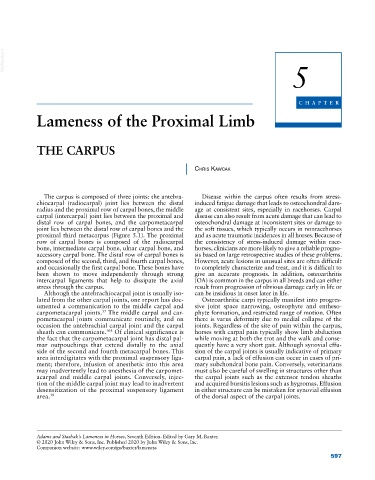Page 631 - Adams and Stashak's Lameness in Horses, 7th Edition
P. 631
VetBooks.ir
5
CHAPTER
Lameness of the Proximal Limb
THE CARPUS
Chris KawCaK
The carpus is composed of three joints: the antebra- Disease within the carpus often results from stress‐
chiocarpal (radiocarpal) joint lies between the distal induced fatigue damage that leads to osteochondral dam-
radius and the proximal row of carpal bones, the middle age at consistent sites, especially in racehorses. Carpal
carpal (intercarpal) joint lies between the proximal and disease can also result from acute damage that can lead to
distal row of carpal bones, and the carpometacarpal osteochondral damage at inconsistent sites or damage to
joint lies between the distal row of carpal bones and the the soft tissues, which typically occurs in nonracehorses
proximal third metacarpus (Figure 5.1). The proximal and as acute traumatic incidences in all horses. Because of
row of carpal bones is composed of the radiocarpal the consistency of stress‐induced damage within race-
bone, intermediate carpal bone, ulnar carpal bone, and horses, clinicians are more likely to give a reliable progno-
accessory carpal bone. The distal row of carpal bones is sis based on large retrospective studies of these problems.
composed of the second, third, and fourth carpal bones, However, acute lesions in unusual sites are often difficult
and occasionally the first carpal bone. These bones have to completely characterize and treat, and it is difficult to
been shown to move independently through strong give an accurate prognosis. In addition, osteoarthritis
intercarpal ligaments that help to dissipate the axial (OA) is common in the carpus in all breeds and can either
stress through the carpus. result from progression of obvious damage early in life or
Although the antebrachiocarpal joint is usually iso- can be insidious in onset later in life.
lated from the other carpal joints, one report has doc- Osteoarthritic carpi typically manifest into progres-
umented a communication to the middle carpal and sive joint space narrowing, osteophyte and entheso-
carpometacarpal joints. The middle carpal and car- phyte formation, and restricted range of motion. Often
37
pometacarpal joints communicate routinely, and on there is varus deformity due to medial collapse of the
occasion the antebrachial carpal joint and the carpal joints. Regardless of the site of pain within the carpus,
sheath can communicate. 103 Of clinical significance is horses with carpal pain typically show limb abduction
the fact that the carpometacarpal joint has distal pal- while moving at both the trot and the walk and conse-
mar outpouchings that extend distally to the axial quently have a very short gait. Although synovial effu-
side of the second and fourth metacarpal bones. This sion of the carpal joints is usually indicative of primary
area interdigitates with the proximal suspensory liga- carpal pain, a lack of effusion can occur in cases of pri-
ment; therefore, infusion of anesthetic into this area mary subchondral bone pain. Conversely, veterinarians
may inadvertently lead to anesthesia of the carpomet- must also be careful of swelling in structures other than
acarpal and middle carpal joints. Conversely, injec- the carpal joints such as the extensor tendon sheaths
tion of the middle carpal joint may lead to inadvertent and acquired bursitis lesions such as hygromas. Effusion
desensitization of the proximal suspensory ligament in either structure can be mistaken for synovial effusion
area. 38 of the dorsal aspect of the carpal joints.
Adams and Stashak’s Lameness in Horses, Seventh Edition. Edited by Gary M. Baxter.
© 2020 John Wiley & Sons, Inc. Published 2020 by John Wiley & Sons, Inc.
Companion website: www.wiley.com/go/baxter/lameness
597

